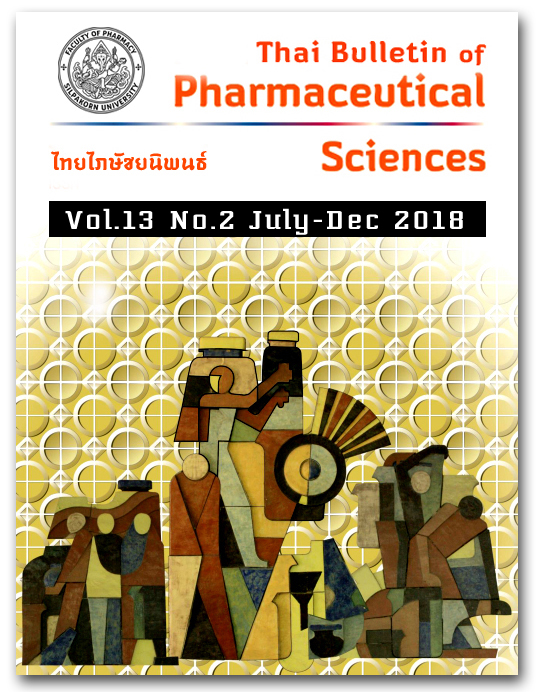พฤติกรรมและทัศนคติในการเขียนซองยาตามวิธีปฏิบัติทางเภสัชกรรมชุมชนที่ดี ของเภสัชกรชุมชนภาคเหนือ
DOI:
https://doi.org/10.69598/tbps.13.2.117-127คำสำคัญ:
behaviors, community pharmacists, medicine labelling, good pharmacy practiceบทคัดย่อ
งานวิจัยเชิงสำรวจนี้มีวัตถุประสงค์เพื่อสำรวจความครบถ้วนของข้อมูลบนซองยา พฤติกรรมการเขียนซองยา และทัศนคติต่อความสำคัญของข้อมูลบนซองยาตามหลักวิธีปฏิบัติทางเภสัชกรรมชุมชนที่ดีของเภสัชกรชุมชนในพื้นที่ภาคเหนือ เก็บข้อมูลโดยใช้แบบสอบถามทางไปรษณีย์กลุ่มตัวอย่างเป็นร้านขายยาแผนปัจจุบัน (ขย.1) ที่ตั้งอยู่ในพื้นที่ 8 จังหวัดภาคเหนือ จำนวน 279 ร้าน แบบสอบถามที่ถูกนำมาวิเคราะห์ จำนวน 49 ฉบับ (17.6%) ผลการศึกษาพบว่า ด้านความครบถ้วนของข้อมูลบนซองยาไม่มีร้านยาใดที่มีข้อมูลบนซองยาครบถ้วนตามที่วิธีปฏิบัติทางเภสัชกรรมชุมชนที่ดีกำหนด ข้อมูลที่ปรากฏบนซองยามากที่สุด คือ วิธีการใช้ยา (49 คน, 100%) ข้อบ่งใช้ (46 คน, 93.9%) และคำแนะนำหรือคำเตือน (44 คน, 89.9%) ด้านพฤติกรรมการเขียนซองยาพบว่าไม่มีเภสัชกรผู้ตอบแบบสอบถามคนใดที่เขียนซองยาได้ครบเช่นกันข้อมูลที่ผู้ตอบแบบสอบถามเขียนทุกครั้งมากที่สุด คือ วิธีการใช้ยา (37 คน, 75.5%) ข้อบ่งใช้ (33 คน, 67.3%) และ ชื่อ ที่อยู่ และหมายเลขโทรศัพท์ของร้านยา (29 คน, 59.2%) ข้อมูลที่ไม่เคยเขียนมากที่สุด ได้แก่ ลายมือชื่อเภสัชกร (38 คน, 77.6%) ชื่อผู้รับบริการ (30 คน, 61.2%) และวันที่จ่ายยา (23 คน, 46.9%) ด้านทัศนคติต่อความสำคัญของข้อมูลบนซองยา ผู้ตอบแบบสอบถามเห็นว่าข้อมูลที่สำคัญมากที่สุดคือ วิธีการใช้ยา (4.92 ± 0.27) ข้อบ่งใช้ (4.80 ± 0.46) และคำแนะนำหรือคำเตือน (4.57 ± 0.68) ข้อมูลที่มีความสำคัญน้อยที่สุด คือ ลายมือชื่อเภสัชกร (2.55 ± 1.14) ชื่อผู้รับบริการ (2.82 ± 1.19) และจำนวนยาที่จ่าย (3.02 ± 1.18) สรุปได้ว่าร้านยาส่วนมากมีข้อมูลที่แสดงบนซองยาไม่ครบถ้วน รวมถึงเภสัชกรชุมชนเขียนข้อมูลบนซองยาไม่ครบถ้วนตามวิธีปฏิบัติทางเภสัชกรรมชุมชนที่ดีกำหนด และมีทัศนคติต่อข้อมูลที่กำหนดบางประเด็นในระดับต่ำ
เอกสารอ้างอิง
2. Bureau of Drug Control, Food and Drug Administration. Ministry of Public Health. Statistics of nationwide licensed drug stores 1996-2013. [Online]. 2013. [cited 2016 Jun 23]; Available from: https://www.fda.moph.go.th/sites/Drug/ SitePages/Queries.aspx (in Thai)
3. Tangploy S. Drug buying behavior for the drug stores among consumers in Phrapradaeng district, Samutprakran [master’s thesis]. Bangkok: Srinakharinwirot University; 2010. 224p. (in Thai)
4. Mathuros P. The study of consumer behavior and attitude toward drugstore in Mueang district, Phang Nga province. FDA J. 2014;32-40. (in Thai)
5. Parinyarux P, Suwannaprom P. Attitudes and stage of change towards participation to the community pharmacy development and accreditation project of pharmacists drug store owners in Muang district, Chiang Mai province. Thai Pharm Health Sci J. 2014:9(4):164-9. (in Thai)
6. Settasoontari P. Factors affecting the drugstores’ tendency to join the pharmacy advancement project for quality drugstores.Dep Health Serv Support J. 2013:9(1); 44-56. (in Thai)
7. Thavornwattanayong W, Yuklanthuan C, Panyakrua P, Nakarin R, Athitrakoonlert E. Pharmacy owner’s opinions in Nakorn Pathom province on the notification of the ministry of public health B.E. 2557 (2014) on the regulations of setting, equipment and pharmacy practice. Thai Bull Pharm Sci. 2016;11(2):27-44. (in Thai)
8. Wimonkittipong S, Panthong M. Guideline to achieve mandatory GPP regulation. Nonthaburi: Bureau of Drug Control,Ministry of Public Health, 2015. (in Thai)
9. Wimonkittipong S. The ability of drug stores to develop for attain the (draft) notification of the ministry of public health on good pharmacy practice. Nonthaburi: Bureau of Drug Control,Ministry of Public Health, 2015. (in Thai)
10. Plianbangchang P, Hongsamut D. Drugstore owners’ opinions on drugstore standards of the Pharmacy Council: a nation-wide survey. J Health Sci. 2006;15(1):111-22. (in Thai)
11. Boonchoong N, Chanakij T, Dorkrakklang P, Wongsa P, Sootsol S, Yospanya S. Compliance with the community pharmacy project after accreditation by the pharmacy council. KKU Res J. 2007;12(1):53-65. (in Thai)
12. Kaew-on P, Lerkiatbundit S, Saengcharoen W. Is there any difference in the quality between the pharmacies accredited by the pharmacy council and non-accredited pharmacies? Thai J Pharm Pract. 2012;4(2):39-64. (in Thai)
13. Nontaleeruk P, Intharapong S, Plianbangchang P. Community pharmacists’ medicine labeling behavior in Bangkok and its metropolitian areas. Naresuan Univ J. 2006;14(3):27-34. (in Thai)
14. Bernard HR. Social research methods: qualitative and quantitative approaches. California: Sage Publications; 2000.
15. The Pharmacy Council of Thailand. The skill manual of professional competencies of pharmacy profession. Nonthaburi: The Pharmacy Council of Thailand, 2011. (in Thai)
16. Ross JA. The reliability, validity, and utility of self-assessment. PARE. 2006;10(11):1-8.
17. Eva KW, Regehr G. Self-assessment in the health professions: a reformulation and research agenda. Acad Med. 2005;80(10 Suppl):S46-54.
18. Stojkov S, Tadic I, Crnjanski T, Krajnovic D. Assessment and self-assessment of the pharmacist’s competencies using the Global Competency Framework (GbCF) in Serbia. VojnosanitPreg. 2016;73(9)803-20.
19. Saengcharoen W, Chongsuvivatwong V, Lerkiatbundit S and Wongpoowarak P. Client and pharmacist factors affecting practice in the management of upper respiratory tract infection presented in community pharmacies: a simulated client study. Int J Pharm Pract. 2008;16:265-70.
20. Saengcharoen W, Lerkiatbundit S. Migraine management in community pharmacies: practice patterns and knowledge of pharmacy personnel in Thailand. Headache. 2013;53(9):1451-63.



